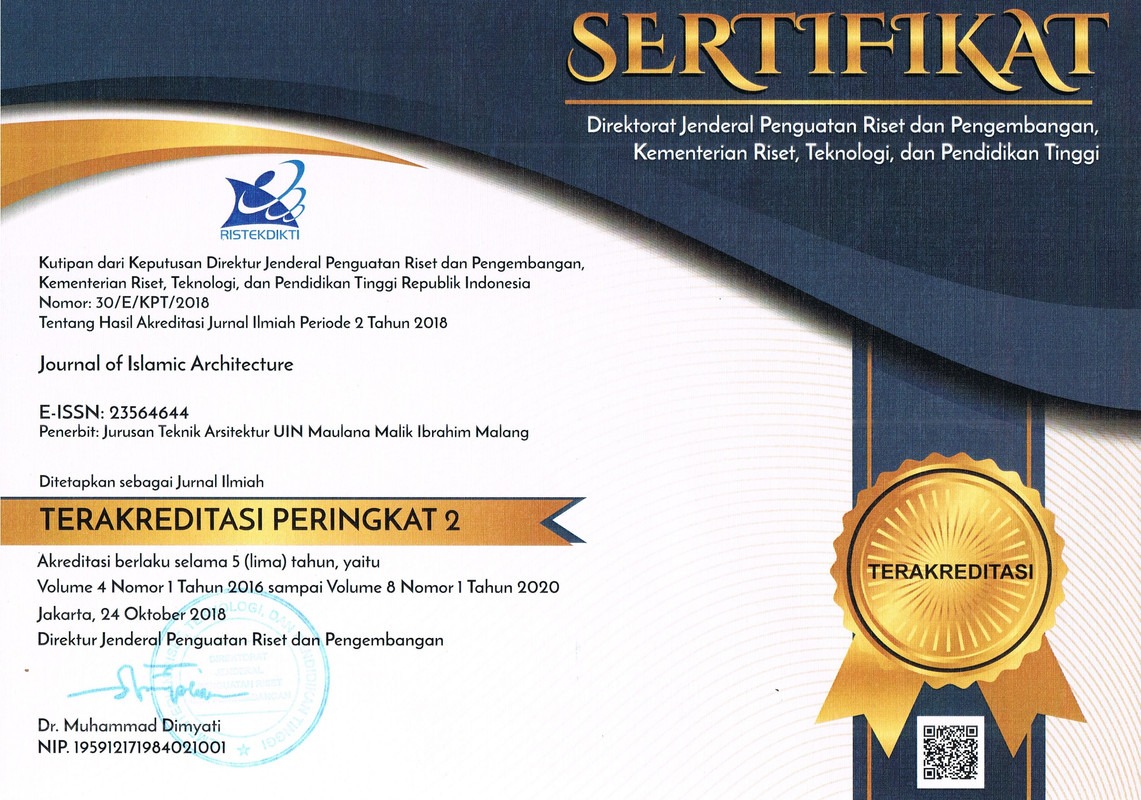CULTURAL RESILIENCE IN KAMPUNG MAHMUD AS AN EFFORT TO PRESERVE HISTORIC AREA
Abstract
In order to achieve the concept of sustainable cities and communities, the historical and cultural richness of a city becomes one of the main sustainability modalities. The historical and cultural heritage of a city should be an important object protected by its existence and provide an identity. One of the important cultural heritages around Bandung is Kampung Mahmud. Kampung Mahmud is located 1.5 kilometres from the city of Bandung. This traditional village still holds the customs as cultural heritage and contribute to the development and spread of Islam in the city of Bandung. The existence of this village becomes an irony when its location lies between city life with all its modernity. How can the traditional kampung be able to have cultural resilience against other influences and challenges that can threaten sustainability? The study aimed to find the role of cultural resilience in Kampung Mahmud. The method used is a qualitative method that relates the instrument of cultural resilience theory to the facts that occur in the object of study. The output of this research is the principles of cultural resilience is successfully applied to Kampung Mahmud and can be an example for other regions.
Keywords
Full Text:
PDFReferences
M. García-Hernández, M. de la Calle-Vaquero, and C. Yubero, “Cultural Heritage and Urban Tourism: Historic City Centres under Pressure,” Sustainability, vol. 9, no. 8, p. 1346, Aug. 2017.
W. D. Pratiwi, I. Susanti, and Samsirina, “The Impact of Religious Tourism on a Village of Peri-urban Bandung: Transformation in Placemaking,” in Proceedings of the 6th International Conference of Arte-Polis, Singapore: Springer Singapore, 2017, pp. 61–72.
N. Nurdiani and W. Katarina, “The study of buildings and neighborhood of Mahmud cultural village,” IOP Conf. Ser. Earth Environ. Sci., vol. 195, no. 1, 2018.
M. Gartiwa, “Climate Adaptive Technology In Maintaining Vernacularism Of Urban Kampong Case study : KampungAdat ( Indiginous ) Mahmud , Bandung District , West Java,” no. Icetd, 2013.
P. Indonesia, Undang-Undang Nomor 11 tahun 2010 tentang Cagar Budaya. Indonesia, 2010.
P. Indonesia, Undang-Undang Nomor 5 tahun 1992 tentang Benda Cagar Budaya. Indonesia, 1992.
P. DKI, Pemerintah DKI Nomor 9 tahun 1999 tentang Pelestarian dan Pemanfaatan Lingkungan dan Bangunan Cagar Budaya. Indonesia, 1999.
UNESCO, Protection of the World Cultural and Natural Heritage. 1987.
J. Blake, “On Defining the Cultural Heritage,” Int. Comp. Law Q., vol. 49, no. 1, pp. 61–85, Jan. 2000.
B. Hernowo, D. S. Agustina, and A. H. Lulu, “Heritage Facadism And Its Concept Of Value,” in 2nd International Conference On Urban Heritage And Sustainable Infrastructure Development (UHSID), 2013.
B. Hernowo and A. Erdoğan, “Jakarta as Freilichtmuseum of Architectural History,” in PROCEEDING, Jak_A2014: Jakarta as a City and Dream, 2014, pp. 1–13.
L. Prosper, “Wherein Lies the Heritage Value? Rethinking the Heritage Value of Cultural Landscapes from an Aboriginal Perspective,” George Wright Forum, vol. 24, no. 2, pp. 117–124, 2007.
L. H. Fredheim and M. Khalaf, “The significance of values: heritage value typologies re-examined,” Int. J. Herit. Stud., vol. 22, no. 6, pp. 466–481, Jul. 2016.
H. D. Ismadi, Ketahanan Budaya Pemikiran dan Wacana. Jakarta: Pusat Penelitian dan Pengembangan Kebudayaan, Insignia, 2014.
J. H. McMillan and S. Schumacher, Research in Education. New York: longman, Inc, 2001.
Sugiyono, Metode Penelitian Kuantitatif, Kualitatif dan R&D. Bandung: Afabeta, 2011.
K. Karamarkos, R. Eppich, A. Kulmer, and J. C. Espada, “Community Resilience, Cultural Identity and Heritage: Nympheo, Greece, and the HISTCAPE Project,” Practice Insights, vol. 3, Scotland, pp. 18–19, 2014.
Z. P. Syahadah, “Kampung Mahmud dan Sisa Kearifan Lokalnya,” Komunitas Aleut, 2015. [Online]. Available: https://komunitasaleut.com/2015/09/30/kampung-mahmud-dan-sisa-kearifan-lokalnya/. [Accessed: 20-May-2018].
“National Geographic Indonesia,” 2013.
K. Bandung, “Kampung Adat Mahmud,” Disparbud. Jabarprov, 2011. [Online]. Available: http://www.disparbud.jabarprov.go.id/wisata/dest-det.php?id=25〈=id. [Accessed: 20-Apr-2018].
N. Abdurohman and M. Z. Atsari, “Kampung Adat Mahmud, tanah suci umat Islam di Bandung,” Merdeka.com, 2016. [Online]. Available: https://www.merdeka.com/peristiwa/kampung-adat-mahmud-tanah-suci-umat-islam-di-bandung.html. [Accessed: 20-May-2018].
DOI: https://doi.org/10.18860/jia.v5i3.5031
Refbacks
- There are currently no refbacks.






